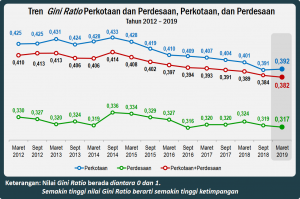Indonesias Gini Ratio Down 0.002 Points
 Inequality level in terms of expenditure among Indonesians as measured by Gini Ratio in March 2019 was recorded at 0.382, the Central Statistics Agency (BPS) has reported.
Inequality level in terms of expenditure among Indonesians as measured by Gini Ratio in March 2019 was recorded at 0.382, the Central Statistics Agency (BPS) has reported.
This figure decreased by 0.002 points compared to Gini Ratio in September 2018 recorded at 0.384, and decreased by 0.007 points compared to that in March 2018 recorded at 0.389, Head of the BPS Suhariyanto said in Jakarta, Monday (15/7).
In terms of area of residence, Suhariyanto added that Gini Ratio in urban areas in March 2019 was 0.392, rising by 0.001 points compared to that in September 2018 at 0.391. Meanwhile, compared to that in March 2018, the ratio was 0.40, lower by 0.009 points, he added.
For rural areas, Suhariyanto continued, Gini Ratio in March 2019 was recorded at 0.317, slightly down by 0.002 points compared to that in September 2018 at 0.319 and decreased by 0.007 points compared to that in March last year 0.324.
Suhariyanto further explained that in addition to Gini Ratio, another measure of inequality often used is the percentage of expenditure in the lowest 40 percent of the population group, known as the World Bank index.
Based on this measure, t level of inequality is divided into 3 categories, namely high inequality if the percentage of expenditure of the population of the lowest 40 percent population group is below 12 percent, moderate inequality if the percentage ranges from 12-17 percent, and low inequality if the figure is above 17 percent.
Suhariyanto went on to explain that in March 2019, the nationals percentage was recorded at 17.71 percent meaning it was in the category of low inequality. The condition improved compared to that in September 2018 recorded at 17.47 percent and March 2018 recorded at 17.29 percent, he added
“This means that there has been an improvement in the level of inequality during the period March 2018-March 2019,” he said.
According to Suhariyanto, the change in the level of inequality was strongly influenced by the large variation in changes in spending between population groups, adding that if changes in expenditure of the lower class population are faster than those in the upper and middle population, expenditure inequality will improve.
In the meantime, citing data from the National Socio-Economic Survey (Susenas), Suhariyanto stated that the increase in average per capita expenditure per month in the period of September 2018-March 2019 for the lowest 40 percent population group increased faster than the 40 percent middle class population and 20 percent highest.
The increase for the lowest 40 percent population group, 40 percent middle class, and the highest 20 percent, respectively are 2.48 percent, 0.71 percent, and 0.95 percent.
Suhariyanto further said that in March 2019, province with the highest Gini Ratio is Yogyakarta Special Region Province at 0.423, while the lowest is Bangka Belitung province with a Gini Ratio of 0.269.
“Compared to the national Gini Ratio of 0.382, eight provinces report higher Gini Ratio, namely Yogyakarta Special Region (0.423), Gorontalo (0.407), West Java (0.402), Southeast Sulawesi (0.399), DKI Jakarta (0.394) ), Papua (0.394), South Sulawesi (0.389), and West Papua (0.386), Suhariyanto said. (Public Relations BPS / ES)
Translated by: Estu Widyamurti
Edited by: M. Ersan Pamungkas








